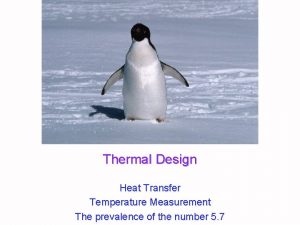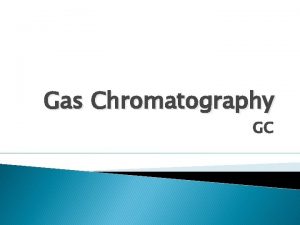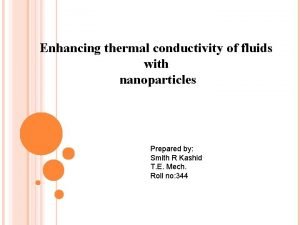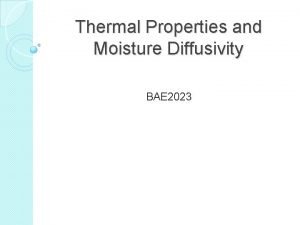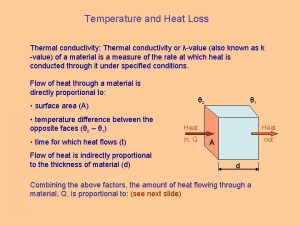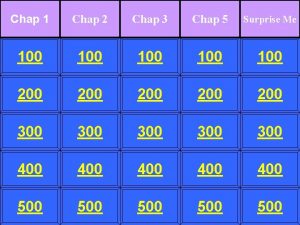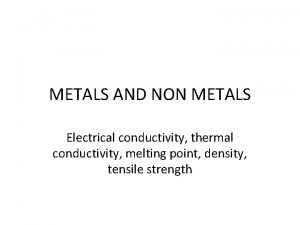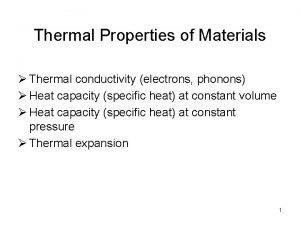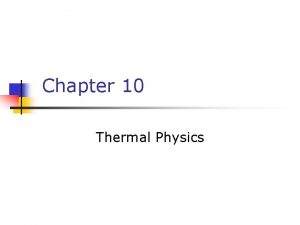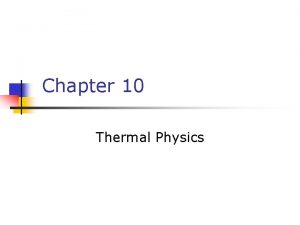Chap 7 Thermal Properties In physics thermal conductivity

![Chap. 7. Thermal Properties 부산대학교 재료공학부 [Thermal Properties] 계면공학 연구실 Chap. 7. Thermal Properties 부산대학교 재료공학부 [Thermal Properties] 계면공학 연구실](https://slidetodoc.com/presentation_image_h2/a797fb7d7733877b224025ff873822b8/image-2.jpg)



![Chap. 7. Thermal Properties Heat Transfer Mechanism: Conduction, Convection, Radiation [Vacuum Bottle] 부산대학교 재료공학부 Chap. 7. Thermal Properties Heat Transfer Mechanism: Conduction, Convection, Radiation [Vacuum Bottle] 부산대학교 재료공학부](https://slidetodoc.com/presentation_image_h2/a797fb7d7733877b224025ff873822b8/image-6.jpg)




![[Nature] Chap. 7. Thermal Properties u Laser Flash Analysis (LFA): thermal diffusivity ( ) [Nature] Chap. 7. Thermal Properties u Laser Flash Analysis (LFA): thermal diffusivity ( )](https://slidetodoc.com/presentation_image_h2/a797fb7d7733877b224025ff873822b8/image-11.jpg)
![Chap. 7. Thermal Properties [Homework #7] / Due date: before next class 1. Describe Chap. 7. Thermal Properties [Homework #7] / Due date: before next class 1. Describe](https://slidetodoc.com/presentation_image_h2/a797fb7d7733877b224025ff873822b8/image-12.jpg)
- Slides: 12

Chap. 7. Thermal Properties In physics, thermal conductivity (often denoted k, λ, or κ) is the property of a material to conduct heat [LED or CPU] v Major carrier in thermal conduction: electron s and phonon(thermal vibration). Cf. Electrical properties: electrons [holes] and ions. 부산대학교 재료공학부 [Thermal Properties] 계면공학 연구실
![Chap 7 Thermal Properties 부산대학교 재료공학부 Thermal Properties 계면공학 연구실 Chap. 7. Thermal Properties 부산대학교 재료공학부 [Thermal Properties] 계면공학 연구실](https://slidetodoc.com/presentation_image_h2/a797fb7d7733877b224025ff873822b8/image-2.jpg)
Chap. 7. Thermal Properties 부산대학교 재료공학부 [Thermal Properties] 계면공학 연구실

Chap. 7. Thermal Properties u The heat capacity (열용량) is the energy required to raise the temperature of one mole of a material by one degree. [cal/mol • K] u The specific heat capacity (비열) is defined as the energy needed to increase the temperature of one gram of a material by 1℃. [cal/g • K] v Neither the heat capacity nor the specific heat capacity depends significantly on the structure of the material; thus, changes in dislocation density, grain size, or vacancies have little effect. v The most important factor affecting specific heat capacity (비열) is the lattice vibration (or phonons). 부산대학교 재료공학부 [Thermal Properties] 계면공학 연구실

Chap. 7. Thermal Properties u. Thermal conductivity : the rate of heat transfer through a material in steady state. It is not easily measured, especially for materials with low conductivity but reliable data is readily available for most common materials. u. Thermal conductivity (λ) is the intrinsic property of a material which relates its ability to conduct heat. Heat transfer by conduction involves transfer of energy within a material without any motion of the material as a : where Cp is specific heat λ = Cp whole. u. Energy is transferred from the more energetic to the [Thermal Properties] 계면공학 연구실 부산대학교 재료공학부

Chap. 7. Thermal Properties u Thermal Conductivity of Ceramics: Thermal conduction is generated by the movement of electrons and the transfer of lattice vibrations. For ceramics, factors such as internal porosity, grain boundaries and impurities can affect this property. 부산대학교 재료공학부 [Thermal Properties] 계면공학 연구실
![Chap 7 Thermal Properties Heat Transfer Mechanism Conduction Convection Radiation Vacuum Bottle 부산대학교 재료공학부 Chap. 7. Thermal Properties Heat Transfer Mechanism: Conduction, Convection, Radiation [Vacuum Bottle] 부산대학교 재료공학부](https://slidetodoc.com/presentation_image_h2/a797fb7d7733877b224025ff873822b8/image-6.jpg)
Chap. 7. Thermal Properties Heat Transfer Mechanism: Conduction, Convection, Radiation [Vacuum Bottle] 부산대학교 재료공학부 Vacuum Bottle 계면공학 연구실

Chap. 7. Thermal Properties u Hot Disk Method: How is the measurement made? The disk sensor is placed between two pieces of the sample material and is then heated by a constant electrical current for a short period of time. [ Thermal conductivity ] 부산대학교 재료공학부 Hot Disk Method 계면공학 연구실

Chap. 7. Thermal Properties u Laser Flash Analysis (LFA): thermal diffusivity ( ) thermal conductivity (λ) λ = Cp t 1/2 부산대학교 재료공학부 LFA 계면공학 연구실

Chap. 7. Thermal Properties Specific Heat Capacity: The specific heat capacity refers to the amount of heat required to cause a unit of mass (say a gram or a kilogram) to change its temperature by 1°C. [Measurement of Cp by Differencial Scanning Calorimeter] 부산대학교 재료공학부 Specific Heat Capacity 계면공학 연구실

Chap. 7. Thermal Properties Metal: 10~25, Polymer: 50~100, Ceramics: 3~7 ppm TCE: Polymer > Metal > Ceramics The linear coefficient of thermal expansion at room temperature for selected materials 부산대학교 재료공학부 TCE 계면공학 연구실
![Nature Chap 7 Thermal Properties u Laser Flash Analysis LFA thermal diffusivity [Nature] Chap. 7. Thermal Properties u Laser Flash Analysis (LFA): thermal diffusivity ( )](https://slidetodoc.com/presentation_image_h2/a797fb7d7733877b224025ff873822b8/image-11.jpg)
[Nature] Chap. 7. Thermal Properties u Laser Flash Analysis (LFA): thermal diffusivity ( ) thermal conductivity (λ) TIM: thin interface materials 부산대학교 재료공학부 www. nature. com/scientificreports 계면공학 연구실
![Chap 7 Thermal Properties Homework 7 Due date before next class 1 Describe Chap. 7. Thermal Properties [Homework #7] / Due date: before next class 1. Describe](https://slidetodoc.com/presentation_image_h2/a797fb7d7733877b224025ff873822b8/image-12.jpg)
Chap. 7. Thermal Properties [Homework #7] / Due date: before next class 1. Describe the principle of heat-transfer blocking in Vacuum Bottle. 2. Describe the measuring principle of thermal conductivity by Hot Disk in detail. 3. Describe the measuring principle of thermal conductivity by LFA in detail. 4. Describe the measuring principle of Cp by DSC in detail. 부산대학교 재료공학부 계면공학 연구실
 Chap chap slide
Chap chap slide Thermal conductivity of styrofoam
Thermal conductivity of styrofoam Electrical conductivity property of matter
Electrical conductivity property of matter Example
Example Thermal conductivity detector
Thermal conductivity detector Properties of dental materials
Properties of dental materials Thermal conductivity detector
Thermal conductivity detector Enhancing thermal conductivity of fluids with nanoparticles
Enhancing thermal conductivity of fluids with nanoparticles Dimension of thermal conductivity
Dimension of thermal conductivity Variable thermal conductivity
Variable thermal conductivity Total thermal conductivity
Total thermal conductivity Convection heat transfer
Convection heat transfer Variable thermal conductivity
Variable thermal conductivity

